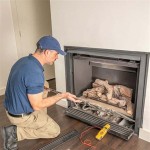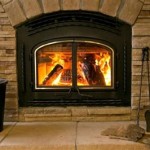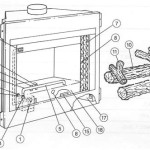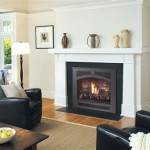Vented Propane Fireplace With Blower: A Comprehensive Overview
Vented propane fireplaces with blowers offer a compelling alternative to traditional wood-burning fireplaces and ventless propane models. These appliances provide a combination of aesthetic appeal, efficient heating, and controlled exhaust, making them a desirable option for homeowners seeking a reliable and visually pleasing heating solution. Understanding the functionalities and benefits of these systems is crucial for making an informed purchase and ensuring safe and effective operation.
A vented propane fireplace system requires a dedicated venting system to expel combustion byproducts, such as carbon monoxide, outside the home. This venting is typically achieved through a chimney or a direct-vent system. A direct-vent system utilizes two pipes: one to draw in fresh air for combustion and the other to expel exhaust gases. This closed system ensures that the fireplace does not consume air from the room, maintaining indoor air quality. The inclusion of a blower further enhances the heating performance by circulating warm air more effectively throughout the living space.
Key Features and Operational Principles
Vented propane fireplaces with blowers are distinguished by several key features that contribute to their performance and safety. The burner assembly employs a sophisticated design to optimize propane combustion, while the venting system ensures the safe removal of exhaust gases. The blower unit, typically located at the base or within the fireplace enclosure, forces heated air into the room, improving heat distribution and overall heating efficiency.
The operational principle involves the following steps: Propane gas is supplied to the burner assembly through a gas line, regulated by a control valve. The gas is ignited, producing a controlled flame within the firebox. The heat generated by the flame warms the surrounding firebox and components. Simultaneously, the blower unit draws in cooler air from the room, passes it over the heated surfaces of the firebox, and then expels the warmed air back into the room. The venting system evacuates the combustion byproducts outside the building, preventing their accumulation indoors. Temperature and flame height are often adjustable via a thermostat or remote control, enabling users to customize the heating output according to their preferences.
The inclusion of safety features is paramount in vented propane fireplaces. Many models incorporate a flame sensor that automatically shuts off the gas supply if the flame is extinguished, preventing gas leaks. Oxygen Depletion Sensors (ODS) are less common in vented models, but may be included as a redundant safety measure, particularly where ventilation may be compromised. These sensors monitor oxygen levels and shut down the fireplace if levels drop below a safe threshold. The venting system itself acts as a crucial safety mechanism, ensuring that hazardous gases are expelled outside the dwelling.
Advantages of Vented Propane Fireplaces With Blowers
Vented propane fireplaces with blowers offer several advantages compared to other types of fireplaces, including traditional wood-burning fireplaces and ventless propane models. These advantages include improved heating efficiency, enhanced safety, ease of use, and aesthetic flexibility.
The primary advantage lies in their enhanced heating efficiency. The blower unit significantly improves the distribution of heat throughout the room, reducing temperature stratification and creating a more uniform and comfortable environment. This contrasts with traditional fireplaces, where a significant portion of the heat escapes through the chimney. Vented propane fireplaces also provide more controllable heat output than wood-burning fireplaces ensuring consistency and preventing overheating.
Safety is another key benefit. The venting system prevents the accumulation of hazardous combustion byproducts inside the home, minimizing the risk of carbon monoxide poisoning and other health hazards. The use of a sealed combustion chamber further enhances safety. The flame sensor provides an additional layer of protection by preventing gas leaks in the event of flame extinguishment.
Ease of use represents a significant advantage. Vented propane fireplaces are typically equipped with electronic ignition systems and thermostat controls, allowing for easy start-up and precise temperature regulation. Unlike wood-burning fireplaces, they require no wood handling, ash removal, or chimney cleaning, reducing maintenance requirements. Remote control functionality adds convenience, enabling users to adjust settings from the comfort of their seating area.
Aesthetic flexibility is also a major factor. Vented propane fireplaces are available in a wide range of styles, from traditional to contemporary, allowing homeowners to choose a model that complements their existing décor. They can be installed as freestanding units, inserted into existing fireplace openings, or integrated into custom-built enclosures. The flame appearance can also be customized through the selection of different log sets, glass media, or other decorative elements.
Installation and Maintenance Considerations
Proper installation and maintenance are essential for ensuring the safe and efficient operation of a vented propane fireplace with a blower. Installation should be performed by a qualified and licensed technician to ensure compliance with local building codes and manufacturer's instructions. Regular maintenance, including cleaning and inspection, is necessary to maintain optimal performance and prevent potential hazards.
Installation typically involves connecting the fireplace to a propane gas supply line, installing the venting system, and wiring the electrical connections for the blower and control system. The venting system must be properly sized and installed to ensure adequate draft and prevent backdrafting. The gas line connection must be leak-tested to prevent gas leaks. Electrical connections must be properly grounded and protected from moisture. Adherence to local building codes is mandatory to ensure the installation meets safety standards.
Regular maintenance should include the following: Annual inspection of the venting system to ensure it is free of obstructions and in good condition. Cleaning of the burner assembly and firebox to remove dust, debris, and soot. Inspection of the gas line connections for leaks. Testing of the flame sensor and other safety controls to ensure they are functioning properly. Cleaning or replacement of the air filter for the blower unit. Professional servicing by a qualified technician is recommended every one to two years to ensure comprehensive maintenance and address any potential issues. Neglecting maintenance can lead to reduced heating efficiency, increased risk of malfunctions, and potential safety hazards.
Troubleshooting common issues can also be important. If the fireplace fails to ignite, check the propane supply, ignition system, and flame sensor. If the blower is not functioning, check the electrical connections, motor, and air filter. If the flame is weak or unstable, check the gas pressure and burner assembly. Consulting the manufacturer's instructions and seeking professional assistance are crucial for resolving complex issues.
The placement of the fireplace within the room can significantly impact its performance and effectiveness. Ideally, the fireplace should be located in a central area of the room to maximize heat distribution. It should also be placed away from flammable materials and in a location that allows for easy access for maintenance. Consider the airflow patterns within the room and position the fireplace to optimize the circulation of warm air. Avoid placing furniture or other obstructions in front of the fireplace, as this can impede airflow and reduce heating efficiency. The size of the room should also be considered when selecting the appropriate BTU rating for the fireplace to ensure adequate heating without overheating. Proper planning and consideration of these factors will help to maximize the benefits of a vented propane fireplace with a blower.
Cost Considerations: Purchase, Installation, and Operation
The overall cost associated with a vented propane fireplace with a blower encompasses the initial purchase price, installation expenses, and ongoing operational costs. A thorough assessment of these costs is crucial for informed budgeting and financial planning.
The purchase price of a vented propane fireplace with a blower can vary significantly depending on the brand, model, size, features, and aesthetic design. Entry-level models may range from several hundred dollars, while high-end units with advanced features and elaborate designs can cost several thousand dollars. Factors such as the type of venting system required (chimney or direct-vent), the BTU rating, the type of log set or media, and the inclusion of remote control functionality can all influence the purchase price. Researching different models and comparing prices from various retailers can help to identify the best value for a particular budget and heating needs.
Installation expenses can also vary depending on the complexity of the installation and the local labor rates. The installation process typically involves running a propane gas line, installing the venting system, connecting electrical wiring, and setting up the fireplace unit. If a chimney is already present, the installation may be simpler and less costly. However, if a direct-vent system needs to be installed, the cost can be higher due to the need for external venting through an exterior wall. Hiring a qualified and licensed technician is essential to ensure the installation is performed safely and in compliance with local building codes. Obtaining multiple quotes from different contractors can help to ensure a competitive price and quality workmanship.
Operational costs primarily consist of propane fuel consumption and electricity usage for the blower unit. Propane prices can fluctuate depending on market conditions and geographic location. The amount of propane consumed will depend on the frequency and duration of fireplace usage, as well as the BTU rating of the unit. Using the thermostat control to regulate the temperature can help to optimize propane consumption. The electricity usage for the blower unit is typically minimal, but it should be considered when estimating overall operating costs. Regular maintenance, such as cleaning and inspection, can also contribute to operational costs. By factoring in these various expenses, homeowners can gain a realistic understanding of the total cost of ownership for a vented propane fireplace with a blower.

30 Ruby Contemporary Intellifire Touch Direct Vent Fireplace Insert Blower And Remote Electronic Ignition Majestic

35 Ruby Traditional Intellifire Touch Direct Vent Fireplace Insert Blower And Remote Electronic Ignition Majestic

Empire 36 In Millivolt Propane Fireplace With Blower Com

Empire Dvx42fp91lp 42 In Propane Direct Vent Fireplace Mf Blower With Dimmable Light Com

Enviro E Series Gas Or Propane Insert Fireplace Fireplaces By Cameron

25 Ruby Traditional Intellifire Touch Direct Vent Fireplace Insert Blower And Remote Electronic Ignition Majestic

Heat N Glo Paloma Direct Vent Gas Stove

Napoleon Gd70nt Deluxe Zero Clearance Direct Vent Fireplace About 2650 With All Toys Including Blower And Gas

35 Ruby Traditional Intellifire Touch Direct Vent Fireplace Insert Blower And Remote Electronic Ignition Majestic

Thelin Gnome Gas Stove Hearth S Great American Fireplace In Menomonie Wi
Related Posts








